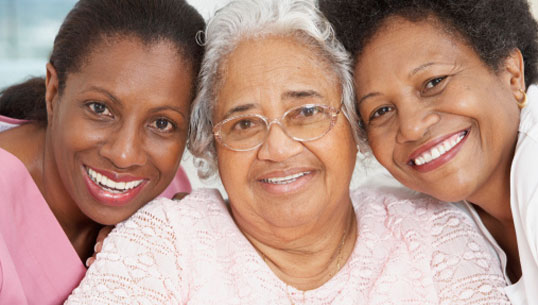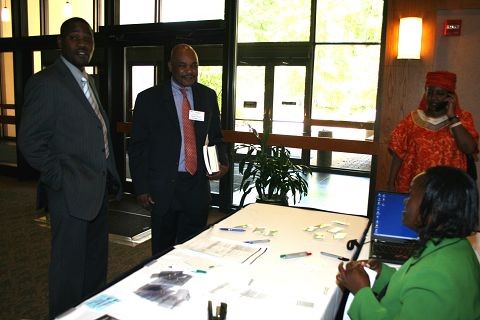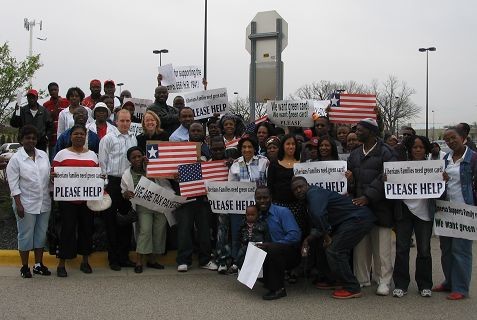
 Considering that Paula Osorio has multiple jobs and no paid sick days, the nosebleed could not have come at a worse time: right before her shift caring for an elderly woman in a private home.
Considering that Paula Osorio has multiple jobs and no paid sick days, the nosebleed could not have come at a worse time: right before her shift caring for an elderly woman in a private home.
In a nursing home or hospital, she would be able to lean on other caregivers. But the patient in her care, 91-year-old Elda Frank, has just her – Osorio, an immigrant from El Salvador.
Thankfully the two women, who have spent a lot of time together for five years, share a deep bond. Osorio cooks Frank’s favorite meals, bathes her and reminds her to take her medicine. Sometimes Osorio even visits Frank on her evenings off because she knows Frank is alone and needs help.
It is this tight-knit relationship that made her feel comfortable to call Frank’s son to suggest that Osorio’s partner, Roberto, go in her place. She then took the day off to go to the doctor.
“I think it’s fine because Roberto is very nice to my mom, too,” said Frank’s son Bruce, a 57-year-old computer engineer and father of three in Foster City. “I told Paula ‘to take the time that you need’, that if she can’t make it, I can find someone or go myself. ”
Osorio has two jobs: she works in Frank’s home during the week and cleans other houses on the weekends. In neither of these jobs is she able to earn paid sick days. When she is sick, she has to choose between going to work ill – and potentially putting the people she works with at risk — or taking the time off to go to the doctor and lose a much-needed paycheck.
In 145 countries, businesses provide workers with paid sick days. But the United States isn’t one of them. Nearly 40 percent of U.S. workers lack access to paid leave to care for themselves or a sick family member.
A Shortage of Caregivers, Many Have No Paid Sick Days
America is suffering from a shortage of caregivers. And of the existing caregivers, many have no basic worker protections like paid sick days.
About one in every eight Americans is 65 or older, a rate that is expected to almost double by 2030 as baby boomers and Generation Xers age, according to the U.S. Administration on Aging. The number of adults requiring care is expected to balloon from 13 million in 2000 to 27 million in 2050, according to Caring Across Generations, a growing national movement anchored by the Domestic Workers Alliance and Jobs With Justice that has a coalition of over 200 organizations. (Disclosure: MomsRising, my employer, is a partner organization of Caring Across Generations.)
Already, many families are scrambling behind closed doors to care or find care for their loved ones while balancing jobs, other dependents – such as children in the home – and other responsibilities. As for the caregivers themselves, they are almost always an afterthought. No one considers what happens to them or their children when they become sick.
A whopping 62 percent of personal care and service workers lack a single paid sick day, according to the Institute for Women’s Policy Research. Besides the emotional and physical costs to caregivers’ families, the lack of a national paid sick days policy has been costly to all U.S. workers and the economy.
Federal legislation called the Healthy Families Act would require employers with 15 or more employees to earn up to seven paid sick days a year. If passed, the Healthy Families Act would expand access to paid sick days to 90 percent of private sector workers. But the bill has stalled in Congress.
Only one state (Connecticut) and a handful of cities (San Francisco, Seattle and Washington, D.C.) guarantee paid sick days to workers. These state and local laws allow workers to accrue paid sick time, typically an hour for every 30 hours worked. A study of the paid sick days law in San Francisco found that after the enactment of the legislation the city had a healthier workforce and actually experienced job growth compared to surrounding areas — including San Mateo County where Osorio works — that don’t have a similar law in place.
These findings contradict that of the U.S. Chamber of Commerce and other business interests that claimed employees would “abuse the system.” Employees ended up using less than half of the days they had accrued, according to the report.
Yet, these same business interests continue to fight paid sick days laws both on the national and local levels. Their effects have been felt in every U.S. household requiring a caregiver.
“I knew a caregiver who needed a hysterectomy,” said Myrla Baldonado, a Filipina caregiver in the Chicago area. “She had to find and pay someone else out of her own pocket so that she could still have a job when she got out of the hospital….This situation of paying somebody to fill in especially when somebody is sick happens all the time. Caregivers keep it a secret that they are going for medical consultations or procedures that might make it appear that they have a serious illness which might cause them to lose their jobs.”
After much soul-searching, Baldonado recently cut back on caregiving to focus on advocating on behalf of caregivers. She is now on staff at the Latino Union of Chicago, although she still fills in for caregiving friends who need time off.
Baldonado said that caregivers are not only vulnerable to exploitive labor conditions but also illnesses in nursing homes and private homes that have sick residents. Due to the physical demands of the job – lifting an elderly person in and out of the bathtub, bed or wheelchair – these workers are also prone to injury.
Every year, employees who come to work sick – many because they lack paid sick days – cost the United States $160 billion. Low-income workers who don’t want to miss a day of pay are very likely to go to work sick, get injured or infect their co-workers and those in their care, which in turn affects other families, too. This is especially true during flu season.
Three years ago, the H1N1 flu pandemic swept through the nation, claiming at least 11,000 lives. What is especially astonishing is that according to research by the University of Pittsburgh, 5 million cases of the flu could have been prevented that year if the United States had simply had a paid sick days policy.
Who Is Caring for Mom?
Osorio is a spry 66-year-old woman, who, even though she is smaller than Frank, has no problem helping her out of bed or off the couch, or bathing her. No matter how unpleasant the task at hand is, Osorio is forever winking, smiling and joking with Frank. “What party are you going to this Sunday?” asked Osorio, who very well knew that Frank had her 91st birthday party coming up.
Osorio was born and raised in the small town of San Ildefonso in San Vicente, El Salvador, a region known for its breathtaking views of the volcanic peaks of Chichontepec. It is also an area of extreme poverty, dotted by multigenerational families living in shacks, barefoot and undernourished children playing with equally skinny and undernourished dogs, and it is not uncommon for poor single mothers to seek work in the country’s capitol San Salvador or the United States.
Osorio herself was raised by a beloved grandmother named Maria. Osorio said she spent her childhood days alongside her abuelita Maria, washing clothes in a river, making their own tortillas and soaps and sleeping outside in a hammock as her abuelita, a midwife, delivered babies.
“She was my mother and father,” Osorio said of her grandmother. “Even after her death, I still feel her in my heart.”
Maria Osorio delivered all four of her granddaughter’s babies and helped raise them until she died before the start of the country’s civil war in 1980. Between 1980 and 1992, the country was entrenched in a bloody civil war that claimed 100,000 lives in a country of six million. During this time, Osorio made tortillas to sell and provide for her four children. She was constantly worried that her daughters would be kidnapped by guerrilla soldiers.
Osorio recalled running home with an armload of wet laundry every time the guerrillas approached the river. Her daughters hid under their beds whenever unknown men came to their home. At times, guerrillas would ask that Osorio feed them. She refused. “I wouldn’t give them anything because I had to pay to make the tortillas!” she said.
It may sound like a gutsy move, but Osorio was very afraid, especially for her oldest daughter, Blanca, who she sent to live with other family members in San Vicente. Blanca would eventually make her way to the United States and send for her mother in 1992. To be with her daughter in California, Osorio would leave behind her three other children, including her youngest, a 12-year-old son named Rene.
“It’s hard,” Osorio said of having to leave behind her children. “I got here and I cried.”
An Opportunity for Immigrant Caregivers, American Families and Economy
“Paula has been a blessing,” Frank’s son, Bruce, said. “She has done so much for my mom. She will come over to see my mom at night out of her own free will. It is amazing what she does. We can’t ask for a better person for my mom.”
Prior to Osorio’s arrival, Frank said his mother went through at least two caregivers provided by the county. In between caregivers, it fell on him to care for his mother, who suffers from dementia, near blindness due to macular degeneration, a heart condition and limited mobility.
The thought of Osorio ever becoming ill troubles him deeply.
“Of course, we always worry,” he said. “If she doesn’t come in, who’s going to take care of my mom? In my mom’s case, she has me. But there are people who don’t have anybody.”
For Jodeen Olguin-Tayler, field director for Caring Across Generations, the aging of the baby boomers presents an opportunity to help both families and caregivers as well as strengthen the U.S. economy.
“Home care workers are sometimes the only support and care that elderly and people with disabilities can rely on to allow them to live at home with dignity and respect,” Olguin-Tayler said. “Ensuring that home care workers have dignified working conditions, including paid sick days, will create stability in the home care industry, and formalize the industry so that it can grow to meet the needs of our country and create the jobs our economy needs to get back on track.”
The U.S. taxpayer is already feeling the pinch of not putting in place basic worker protections like paid sick days. Research shows that paid sick days would decrease the number of stomach flu cases in nursing homes. In California, for example, between 30 and 45 fewer nursing homes would have norovirus outbreaks each year under a paid sick day policy – and these are the homes that are forthcoming about such outbreaks. In Denver, Colorado, which failed to pass a paid sick days policy earlier this year, there were 526 cases of norovirus stomach flu infections in nursing homes in 18 months. Five of these cases led to hospitalizations.
Considering that many of these seniors are covered by public insurance programs like Medicare and Medicaid, the taxpayer should feel leery.
Paid Sick Days Makes a Difference in the Lives of Caregivers
When Osorio first arrived in California in 1992, she cared for two girls in Hayward. The girls’ mother was a nurse who not only paid Osorio when she was sick, but also took her to her clinic for treatment.
“They treated me so well,” Osorio said of the family. “We still keep in touch.”
Eventually, the girls would grow up and it was time for Osorio to find another job. For 10 years, she worked at an industrial Laundromat where she had full benefits, including health insurance. It came in handy. During that time, she contracted uterine cancer and had to miss six months of work for a hysterectomy and 28 treatment sessions.
“I have never dyed my hair,” Osorio said with a grin, as she parted the roots of her dark curly hair to prove it. “Even when I was treated for cancer, I didn’t lose my hair or go gray.”
Osorio credits her faith, relationship with Roberto and love of work that have kept her young during the most arduous moments of her life. Roberto has helped her over the years, whether emotionally or financially. Work has allowed her to sustain herself and send money to her children and grandchildren in El Salvador.
Recently, in Frank’s one-bedroom apartment in San Carlos, Osorio revealed a photo of the plaid-skirted and olive-skinned 11-year-old girl that keeps her going: Rene’s daughter — her granddaughter — Nicole.
Thanks in part to cash remittances from her grandmother, Nicole is attending a private school in San Salvador and not only learning how to read and write in Spanish – but in English, too. “Nicole tells me, ‘I am going to make something of myself,’” Osorio says assuredly.
With that, Osorio flashes her signature smile, tends to Frank and says a little prayer that she won’t get sick. “If something happens to me, who will take care of her?” she wonders aloud.
To learn more and take action on federal legislation for paid sick days, click here. To ensure that domestic workers, including immigrant caregivers, receive basic job protections, learn more about the Caring Across Generations campaign.
About New America Media
New America Media is the country's first and largest national collaboration and advocate of 2000 ethnic news organizations.






